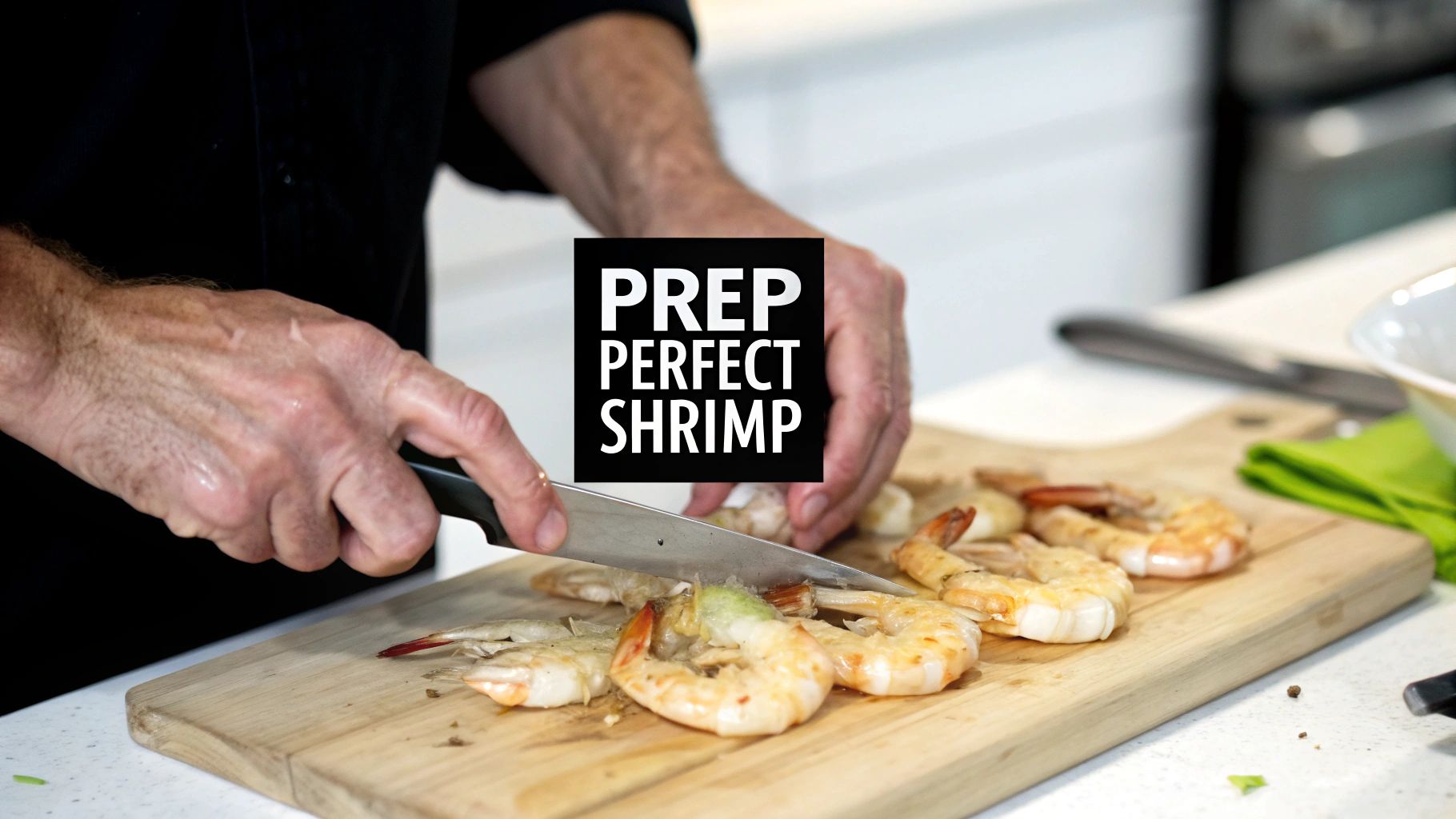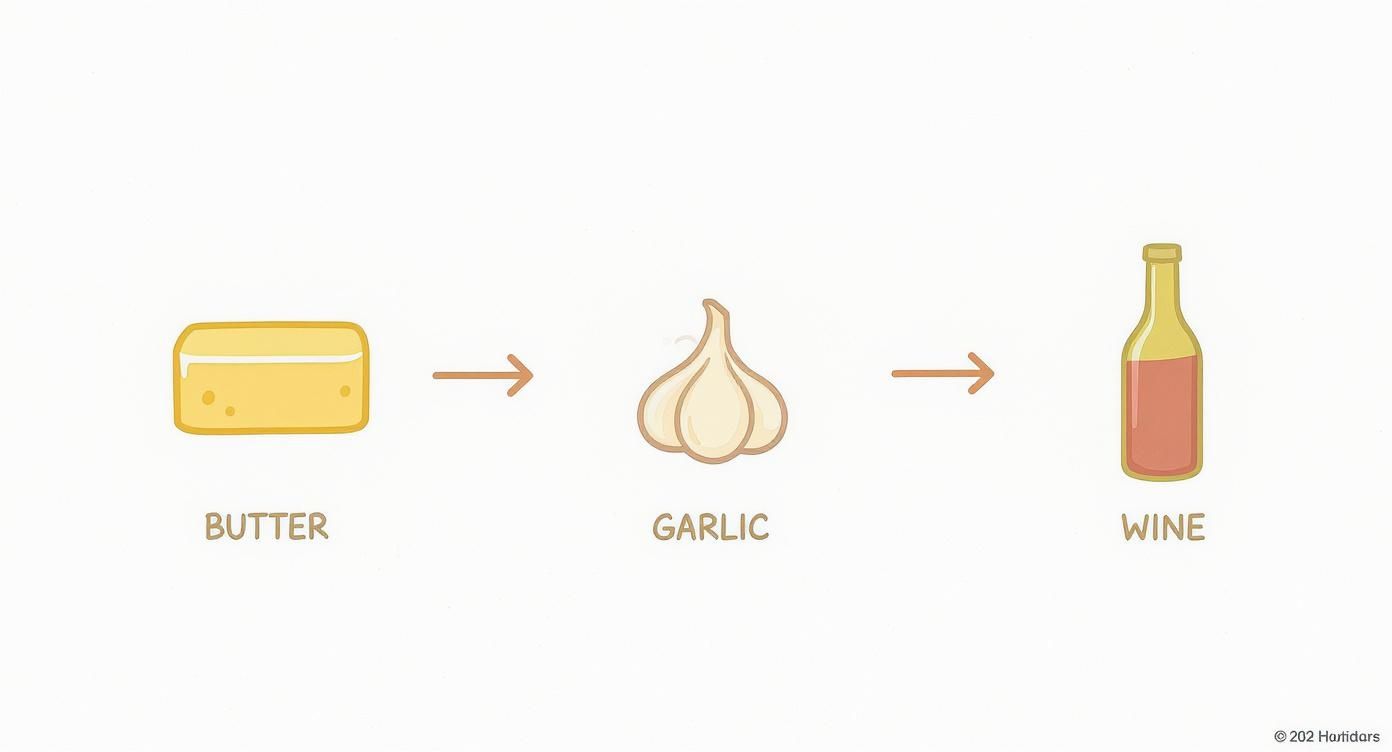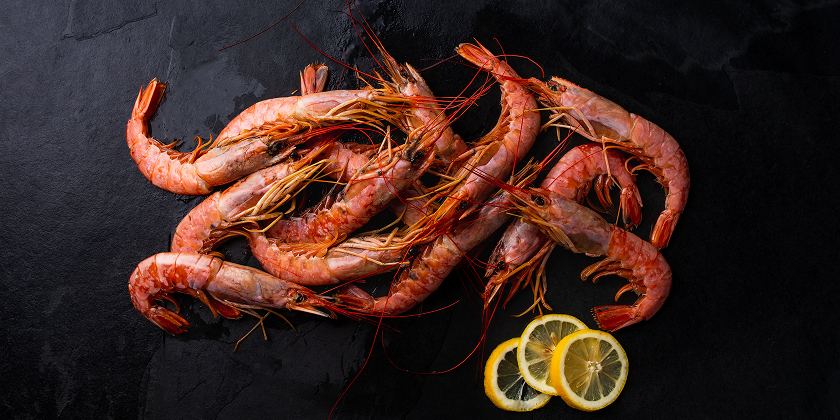Cooking scampi at home is all about nailing a simple, elegant technique: sautéing shrimp in a luxurious sauce of garlic, butter, and white wine. The real secret is speed. You want to cook the shrimp for just 2-3 minutes per side until they turn pink and firm, then pull them out and create a quick pan sauce to coat them perfectly.
Unlocking the Secrets to Perfect Scampi
Ready to make a scampi that tastes like it came straight from your favorite Italian spot? This guide cuts right to the chase, showing you how to master this classic at home. We'll start with the fundamentals—from picking the right shrimp to balancing those essential flavors of garlic, butter, and lemon.
You'll get a clear, actionable overview of the entire process, not just the steps. The goal is to understand the why behind the technique, guaranteeing tender shrimp and a silky, flavorful sauce every single time. Think of this as your roadmap to a perfect plate of scampi.
Why Scampi is a Home Cook's Best Friend
There's a reason shrimp is so popular for quick, delicious meals. Its versatility and fast cooking time have helped fuel a global market valued at approximately USD 72.6 billion in 2023, driven partly by the demand for protein-rich, low-calorie foods. This makes it the ideal ingredient when you need an impressive dinner on the table in minutes.
To get that truly restaurant-quality result, it’s not just about the technique, but about knowing your ingredients inside and out. For a deeper dive into one of scampi's foundational ingredients, check out this guide on mastering how to cook with olive oil.
Core Components for Success
The beauty of scampi is its simplicity, but don't let that fool you—every ingredient plays a crucial role. Understanding what each one brings to the party is the first step toward a flawless dish.
For a quick reference, here's a breakdown of the key players and their roles.
Classic Scampi Ingredients at a Glance
Knowing how these simple components work together is what separates a decent scampi from a truly memorable one.
Here’s a closer look at what makes each one indispensable:
- The Shrimp: The foundation of the dish. Jumbo shrimp (16-20 per pound) give you that perfect, meaty texture.
- The Fat: A combination of olive oil and unsalted butter is classic. The oil has a higher smoke point, while the butter brings irreplaceable flavor and creaminess.
- The Aromatics: Freshly minced garlic is non-negotiable. Its pungent aroma blooms in the fat and defines the entire dish.
- The Sauce: A splash of dry white wine (like Pinot Grigio) and a squeeze of fresh lemon juice cut through the richness and create a balanced, vibrant sauce.
- The Finish: A handful of chopped fresh parsley tossed in at the very end adds a burst of bright, herbaceous flavor and color that ties everything together.
Selecting and Prepping the Perfect Scampi
The secret to incredible scampi doesn't start in the pan. It starts at the seafood counter. Getting this first step right makes all the difference, and it’s simpler than you might think.
First, a pro tip: skip the "fresh" shrimp behind the glass. More often than not, they’re just previously frozen shrimp that have been thawed out, and they lose texture with every passing hour.
Your best move is to buy high-quality frozen raw shrimp. This way, you know they were frozen at their absolute peak. It’s no surprise the market for top-tier frozen options is booming—in fact, the frozen scampi market was recently valued at around USD 1.36 billion.
Choose the Right Size and Type
For scampi, size matters. You want a shrimp that’s meaty and satisfying but doesn’t take forever to cook. Look for a size count of 16-20 per pound, often labeled "jumbo." They’re the perfect balance.
Whenever possible, buy them shell-on. The shells are a secret weapon—they protect the delicate meat during cooking and infuse your sauce with an incredible depth of flavor.
If you really want to elevate the dish, swap the shrimp for traditional langoustines. They have a sweet, almost lobster-like flavor that’s truly next level. Sustainably sourced options, like these beautiful New Zealand scampi, are a fantastic choice for a more authentic, luxurious take.

Thaw and Prep for Success
How you thaw your shrimp is non-negotiable if you want that firm, snappy texture. Whatever you do, don't use the microwave or hot water—it’s a one-way ticket to mushy shrimp.
The Best Way to Thaw: Just place the frozen shrimp in a colander in your sink and run cold water over them for about 5-10 minutes. Give them a gentle toss every so often. They’re ready when they’re flexible but still feel very cold to the touch.
Once they're thawed, it’s time to peel and devein. You can buy them already prepped, but doing it yourself only takes a few minutes and makes a noticeable difference in flavor. Just pinch off the shell, leaving the tail on for that classic scampi look.
To devein, run the tip of a small paring knife down the shrimp’s back to make a shallow cut, then pull out the dark, gritty vein.
The final, crucial step? Pat them completely dry with paper towels. I can’t stress this enough. Dry shrimp will sear beautifully in the hot pan, giving them a gorgeous color and a much better texture. Wet shrimp will just steam.
Building the Perfect Garlic Butter Sauce
The soul of a truly memorable scampi isn't the shrimp—it's the sauce. Forget those thin, oily versions that pool at the bottom of the bowl. We're building a rich, aromatic foundation that clings to every piece of shrimp and pasta.
It all starts with melting real, unsalted butter in a skillet over a gentle, medium-low heat. This isn't a race. That slow melt is your first layer of flavor.
Once it’s liquid and just starting to foam, it’s time for the garlic. You absolutely must use freshly minced garlic, not the stuff from a jar. Toss it in and sauté it carefully. You’re not looking for color here, just that incredible fragrance. The moment you smell that sweet, nutty aroma, pull it. This takes less than a minute.
Elevating the Sauce with Wine and Heat
Next comes the deglazing. Splash in a bit of dry white wine—a Pinot Grigio or Sauvignon Blanc works beautifully. It will sizzle and steam as it hits the hot pan, lifting all those delicious browned bits of flavor from the bottom. That's where the sauce gets its incredible depth.
Let the wine simmer and reduce by about half. This concentrates its bright, acidic notes and cooks off the harshness of the alcohol. This is also the perfect moment to toss in a pinch of red pepper flakes. The goal isn’t fire, but a subtle, background warmth that plays well with the garlic.
The perfect scampi sauce isn't just about ingredients; it’s about technique. Finishing the sauce off the heat by swirling in cold butter creates an emulsion—a creamy, stable sauce that won't separate. This final step is what gives it that signature velvety texture.
Creating a Silky, Emulsified Finish
Once the wine has reduced, take the pan completely off the heat. This is the most important step for getting that creamy, restaurant-quality finish.
Now, add a tablespoon or two of cold butter cubes to the pan. Don't just let them sit there—swirl the skillet constantly. As the butter melts and incorporates, it will thicken the sauce into a glossy, emulsified liquid that coats the back of a spoon. This is the trick that prevents the sauce from breaking and turning greasy.
Finally, toss in a generous handful of chopped fresh parsley for a burst of color and herbaceous freshness. The entire process is quick, which is exactly what you want when working with shrimp. After all, shrimp cook in less than 6 minutes total, so your sauce needs to come together just as fast to preserve their tenderness and moisture. To understand just how critical moisture retention is for quality shrimp, you can review the latest shrimp market insights.
Bringing It All Together in the Pan
This is where the magic happens. Your scampi truly comes to life in the pan, and the secret is all about heat management. So many home cooks make the mistake of using a pan that’s not hot enough, and the result is sad, steamed shrimp instead of beautifully seared ones.
You’re looking for a hot skillet over medium-high heat, but never smoking. The perfect visual cue is a shimmering layer of oil. Just as important: don't overcrowd the pan. Give the shrimp space to cook in a single layer—work in batches if you have to. This guarantees each one gets that perfect, golden-pink sear and the snappy, tender texture you want.
The infographic below shows the simple, foundational flow for building the scampi sauce right in the same pan.

This process isn't just a list of steps. It's about layering flavors—melting the butter, blooming the garlic, and deglazing with wine—to create one cohesive, incredible sauce.
Timing is Everything
Great scampi is a dance of perfect timing. Your pasta should be cooking at the same time, ready to go the moment your sauce is done. I always start boiling the water for the pasta before a single shrimp even hits the pan. Get that pot of salted water to a rolling boil while you’re searing.
The goal is to move the al dente pasta directly from its water into the skillet with the sauce. That starchy pasta water is liquid gold. A splash helps the sauce cling beautifully to every noodle, turning it into a seamless, integrated dish.
Reading the Cues of Doneness
Forget the timer and learn to read the shrimp themselves. They’ll tell you exactly when they’re ready.
You’re looking for two key visual signals:
- Color: They'll go from translucent gray to a vibrant, opaque pink.
- Shape: They'll curl into a gentle ‘C’ shape. That's the sweet spot.
A common pitfall is overcooking. If your shrimp have curled into a tight ‘O’, they’ve gone too far and will be rubbery. Pull them from the heat the second they form that perfect ‘C’.
Once the shrimp are cooked, get them out of the pan and set them aside. Now you can build your sauce in the empty skillet, returning the shrimp at the very end to toss with your just-drained pasta. This method ensures every single component is cooked perfectly.
Creative Twists and Serving Ideas
Once you have the classic scampi down, the real fun begins. Think of the basic recipe as your canvas—a perfect foundation for adding new flavors and textures that play off that rich garlic-butter sauce.
One of the easiest ways to elevate the dish is by tossing in some vegetables right into the pan. Halved cherry tomatoes, added in the last minute of cooking, are a game-changer. They burst just enough to release a sweet, acidic juice that cuts straight through the richness of the butter. For a deeper, more savory flavor, try adding thinly sliced sun-dried tomatoes along with the garlic.

Beyond Traditional Pasta Pairings
While linguine is the go-to, scampi is far too versatile to be tied down to one partner. Changing up what you serve it with can completely transform the meal. For something truly comforting, ladle the scampi and all that glorious sauce over a bed of creamy, soft polenta. The polenta acts like a sponge, soaking up every last drop of flavor.
Serving Pro-Tip: Never underestimate the power of good, crusty bread. A warm baguette is the ultimate tool for sopping up any sauce left on the plate. It ensures not a single drop of that garlicky goodness goes to waste.
If you're looking for lighter, lower-carb options, scampi works beautifully there, too. Consider these alternatives:
- Zucchini Noodles: A fantastic gluten-free choice that keeps the entire dish feeling light and fresh.
- Spaghetti Squash: Its mild, slightly sweet flavor really lets the scampi take center stage.
- Cauliflower Rice: Soaks up the sauce incredibly well, offering a satisfying low-carb twist.
These variations prove just how adaptable the dish is, allowing you to tailor it for any occasion or dietary need. And if you're a fan of garlicky seafood, you should also check out this recipe for Argentine Langostino al Ajilo.
Common Scampi Questions Answered
One of the first questions is always about the wine. Can you skip it? Of course. While a dry white wine like Pinot Grigio gives scampi its signature flavor, you can easily swap it out. A great substitute is chicken or vegetable broth with a generous squeeze of fresh lemon juice. This duo delivers the same bright acidity and savory depth, keeping your sauce perfectly balanced.
Why Is My Shrimp Rubbery?
This is the number one scampi mistake, and the reason is almost always the same: overcooking. Shrimp cook in a flash—we’re talking just two to three minutes. The trick is to trust your eyes, not the timer.
The second they turn from grayish and translucent to opaque pink and curl into a loose ‘C’ shape, they’re done. Get them out of the pan immediately. If they’ve wound up into a tight ‘O’, they’ve gone too far, and you’ll end up with that tough, rubbery texture nobody wants.
Quick tip: The shrimp keep cooking from residual heat after you pull them off the stove. It’s always better to pull them a few seconds early than a few seconds late.
Sourcing also plays a huge role in texture and quality. You can learn more about the world's top shrimp producers and see just how much origin matters.
What Is the Best Pasta for Scampi?
Traditionally, scampi calls for long, thin pasta. These shapes are built to carry the light, buttery sauce without overpowering the delicate flavor of the shrimp.
You can’t go wrong with these classics:
- Linguine: The flat, ribbon-like shape is the quintessential choice for a reason—it holds the sauce beautifully.
- Angel Hair: Its super-fine strands create a lighter, more delicate dish.
- Spaghetti: A classic that everyone loves and that works perfectly every time.
Choosing one of these ensures every single bite gets coated in that garlic-butter goodness you’re looking for.
At WorldClass, we believe exceptional meals start with extraordinary ingredients. Explore our collection of wild-caught seafood and premium provisions to bring unparalleled quality to your kitchen. Discover the difference at https://www.worldclass.com.









.webp)




